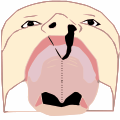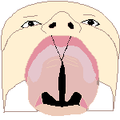Typical facial clefts
From WikiLectures
Typical facial clefts are many times more common than atypical. The most serious are general clefts.
The first genetic group[edit | edit source]
- cleft lip, lip + jaw, general clefts
- one- / two-sided
- complete / incomplete
- more often left-sided
Cleft lip[edit | edit source]
- indicated – a small notch on the border of the lip in red in the place of the 2nd upper incisor
- incomplete – lip split to different heights
- complete – affects the entire lip incl. nostril threshold
Cleft lip and jaw[edit | edit source]
- the jaw can be cleft from a notch on the jaw to a complete cleft of the jaw into the foramen incisivum
- in bilateral cases, the intermaxilla is pushed forward
Split total[edit | edit source]
- the most difficult form I. genetic sk.
- affected lip, jaw and palate
- unilateral: deformation of the alveolar arch
- bilateral: strongly advanced intermaxilla, depression of both lateral segments, nasal skin septum absent
The second genetic group[edit | edit source]
- isolated cleft palate
- partial – soft palate only
- complete – hard and soft palate affected (often up to foramen incisivum)
- submucosal – splayed soft palate muscles covered by intact mucosal duplication + cleft uvula
Cleft microforms[edit | edit source]
- in both genetic studies; disposition to own clefts in offspring
- asymmetric drop of the nose wing
- upper lip scar and coloboma
- deformation of the alveolar arch
- atypia of shape + position of lateral incisors
- Cleft uvula + Gothic palate
Links[edit | edit source]
Related articles[edit | edit source]
External links[edit | edit source]
References[edit | edit source]
MEŠŘÁK, Jan, et al. Introduction to plastic surgery. 1st edition. Prague: Charles University in Prague - Karolinum Publishing House, 2005. 125 pp. ISBN 80-246-1150-3 .









